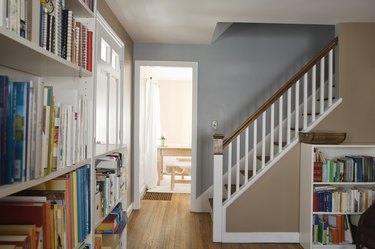
Installing carpet on stairs can be tricky, especially when there is a bullnose on the treads that extends beyond the riser. The easiest and most common installation technique is simply to stretch the carpet over the bullnose and straight down to the next step. This is known as "waterfall" installation. An alternative is to follow the profile of the stair by fitting the carpeting around and under the bullnose before taking it down the riser to the next step. This method is known as upholstering or French tuck installation.
Measuring
Video of the Day
In order to measure for French tuck installation of carpeting on stairs, include measurements for the depth of the bullnose as well as the thickness of the tread. While tread thickness factors into waterfall installation as well, it is not necessary to account for carpet that will cover the underside of the bullnose except in French tuck or upholstered installation.
Video of the Day
Always allow for waste in carpet installation. Experts recommend purchasing 10 percent more carpeting than your precise measurements require.
Fastening
Carpeting may be fastened to stairs using staples, upholstery tacks or tack strips. If you use tack strips to complete your French tuck carpet installation, install one strip at the back of each tread just in front of the riser and another on the underside of the bullnose.
Getting Started
If the floor at the top of the stairs is carpeted, the carpeting should extend underneath the bullnose at the upstairs landing. Stair carpeting will, therefore, begin at the top of the last riser before the landing. Tack or otherwise fasten the carpet to the top of the riser and then stretch it down to where the riser meets the next tread. Use a carpet stretcher to ensure a tight fit and continue downward, fastening the carpet securely under the bullnose of each tread and ending, finally, at the floor.
An Alternate Approach
Some installers break the job up by first carpeting each individual stair tread from where it meets the next riser to the underside of the bullnose and then carpeting the risers separately. To do this, cut individual strips of carpet to fit each riser. In order to avoid "dimples" from staples or tacks in this type of application, you may use a hot glue gun to fasten carpeting to the risers. One advantage of this type of installation is that stained or damaged carpeting can be removed and replaced more easily than with standard installations.